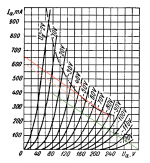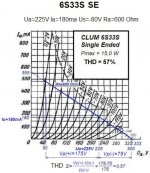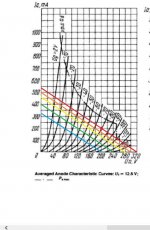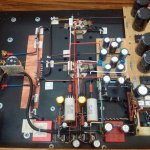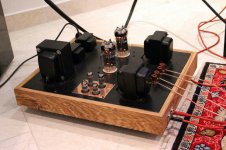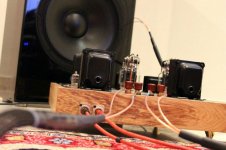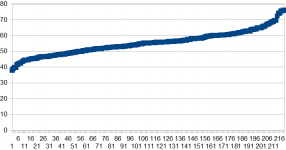hello all
i'm a diyaudio enthusiast that especially work on tubes
not suitable place found in order to find my questions answer
you make me so happy to help me🙂
we have some misunderstanding info about best operation point for 6c33 C or B
actually I built a 6c33set and it complited about a month ago
i'm so happy,the results were satisfying and very nice
the bias point of 6c33 was 🙁plate voltage:200, current:200mA and grid voltage about -72)
of course 12ax7 srpp for input and pre stage and 12bh7 for driver
but now worry obout the operation point😕
opt primary impedance about 600 ohm and Ei96 core
some diyyer say that lower plate voltage and high current can be good for this tube and others say that it's not a long life tube and its better to bias it in higher voltage and lower plate current
which one is correct?
is my operation point good by the help of my opt spec?
i'm a diyaudio enthusiast that especially work on tubes
not suitable place found in order to find my questions answer
you make me so happy to help me🙂
we have some misunderstanding info about best operation point for 6c33 C or B
actually I built a 6c33set and it complited about a month ago
i'm so happy,the results were satisfying and very nice
the bias point of 6c33 was 🙁plate voltage:200, current:200mA and grid voltage about -72)
of course 12ax7 srpp for input and pre stage and 12bh7 for driver
but now worry obout the operation point😕
opt primary impedance about 600 ohm and Ei96 core
some diyyer say that lower plate voltage and high current can be good for this tube and others say that it's not a long life tube and its better to bias it in higher voltage and lower plate current
which one is correct?
is my operation point good by the help of my opt spec?
I've only built one amp with this tube so am no expert but by looking at the data sheets you are well above their specified normal Vp but well under their specified Ip and at only 2/3 their max power dissipation. I'd say you don't need to worry.
Data sheet curves with your 600Ω load line.
Green centred at your given operating point. Red centred at the data sheet specified nominal, and Orange is betwixt the two.
PS. Isn't that where Romy the Cat runs his 6C33 amp? I believe he has a whole forum dedicated to his circuit. Maybe his forum will give you more conclusive data?
Data sheet curves with your 600Ω load line.
Green centred at your given operating point. Red centred at the data sheet specified nominal, and Orange is betwixt the two.
PS. Isn't that where Romy the Cat runs his 6C33 amp? I believe he has a whole forum dedicated to his circuit. Maybe his forum will give you more conclusive data?
Attachments
No worries about tube life. It's the OPT that might hold you back to run the tube with more current. The quiescent current (0.2A) times the PS voltage (200V) asks for at least a 40W unit. You have to check with the manufacturer to find out if your output is capable for higher power. If you would like to raise the quiescent current, see what limit is mentioned in its data sheet. It's the mixture of the distortion that gives the output tube its character (together with the amplified distortion of the preceding stages). By changing the operating point you effect the amplifiers' character.we have some misunderstanding info about best operation point for 6c33 C or B. (plate voltage:200, current:200mA and grid voltage about -72), opt primary impedance about 600 ohm and Ei96 core
my 6c33s se runs@ 204V approx. and 170-200mA,tubes last for long and bias are stable.max . dissipation for 6c33s 60w ,so 40w to 50w imho fine. i also tested some 6c18c at the same working point. post please some pics of your amp!😎
I've only built one amp with this tube so am no expert but by looking at the data sheets you are well above their specified normal Vp but well under their specified Ip and at only 2/3 their max power dissipation. I'd say you don't need to worry.
Data sheet curves with your 600Ω load line.
Green centred at your given operating point. Red centred at the data sheet specified nominal, and Orange is betwixt the two.
PS. Isn't that where Romy the Cat runs his 6C33 amp? I believe he has a whole forum dedicated to his circuit. Maybe his forum will give you more conclusive data?
thank u very much
of course i have checked it more times but in romy's forum most of them are audiophile and tester,not electronic eng or technician in building tube amps
i've ploted some parallel load line (600 ohm) before biasing
of course before biasing i used a japanese scheme,it was so good but the voltage that wrote in the scheme,according to amount of resistors and bias point of other triodes were not correct
so i had to rebias the scheme again
if u want the scheme i can attach it for u
Attachments
No worries about tube life. It's the OPT that might hold you back to run the tube with more current. The quiescent current (0.2A) times the PS voltage (200V) asks for at least a 40W unit. You have to check with the manufacturer to find out if your output is capable for higher power. If you would like to raise the quiescent current, see what limit is mentioned in its data sheet. It's the mixture of the distortion that gives the output tube its character (together with the amplified distortion of the preceding stages). By changing the operating point you effect the amplifiers' character.
thank u
the ps can deliver more that 40w per channel and opt capable for max 250mA
made according to interleaving layout
my exact problem was that grid biased on -70
it means that it swings between -70 to zero for positive cycle
and -70 to -140 for negative cycle
but someone said that this tube is not suiatable for this amount of negative swing on its grid(-140)
and this couse that the tube drop in distortion (exactly the cut-off distortion,sth like cut-off clipping but not clipping)
and this confused me😕
Note that 6C33C spread quite a lot, (as do all high Gm tubes) so grid voltage varies between samples for same anode current and anode voltage. I have measured more than 200 tubes and got grid voltages between 40 and more than 80V for same anode current/voltage.
Dakesue from Sanei company in Japan that discovered 6C33C as an audio tube in the western world , (he was the first outside USSR that imported 6C33C) used 200V and 200-220mA with 600 ohm load. I had one of his amplifiers before, (he sold kits) and used it for about 12 years with the same tubes, at the end they where a bit weak but still functional. What seems to be important is to keep dissipation under about 2/3 of max so about 40W.
6C33C in my OTL amplifiers have very long life, the tubes in my prototype is now 15 years old and still OK, it is a very strong tube, (as long as you don't abuse it)
Dakesue from Sanei company in Japan that discovered 6C33C as an audio tube in the western world , (he was the first outside USSR that imported 6C33C) used 200V and 200-220mA with 600 ohm load. I had one of his amplifiers before, (he sold kits) and used it for about 12 years with the same tubes, at the end they where a bit weak but still functional. What seems to be important is to keep dissipation under about 2/3 of max so about 40W.
6C33C in my OTL amplifiers have very long life, the tubes in my prototype is now 15 years old and still OK, it is a very strong tube, (as long as you don't abuse it)
Hello,
hi
thank u
it's confusing
seems that right now i realize that why in many refrences emphasis that its better to bias your tube around center of your load line
i think that i can bias my triode on every point of load line,but the output distortion vary too much
but the main question is that where is the optimum or good point for biasing a power triode????
😕
my 6c33s se runs@ 204V approx. and 170-200mA,tubes last for long and bias are stable.max . dissipation for 6c33s 60w ,so 40w to 50w imho fine. i also tested some 6c18c at the same working point. post please some pics of your amp!😎
thank u
i attach some pics for u
Attachments
Note that 6C33C spread quite a lot, (as do all high Gm tubes) so grid voltage varies between samples for same anode current and anode voltage. I have measured more than 200 tubes and got grid voltages between 40 and more than 80V for same anode current/voltage.
Dakesue from Sanei company in Japan that discovered 6C33C as an audio tube in the western world , (he was the first outside USSR that imported 6C33C) used 200V and 200-220mA with 600 ohm load. I had one of his amplifiers before, (he sold kits) and used it for about 12 years with the same tubes, at the end they where a bit weak but still functional. What seems to be important is to keep dissipation under about 2/3 of max so about 40W.
6C33C in my OTL amplifiers have very long life, the tubes in my prototype is now 15 years old and still OK, it is a very strong tube, (as long as you don't abuse it)
thank u very much
its amazing to use this tube for 12 or 15 years!!😱
cause that in datasheets and other refrences wrote that 750-1000 hour life
u said that u used 200 tubes and checked them
one strange question is that i had many version of this tube
B or C
i tested two version of 6c33-B
one of them made with otk 17.......and the other otk 37
that was too strange for me because the otk 17 tube in 200v plate and -73grid, anode current will be fixed on 205mA ,and,the otk 37 in 200v plate and -73grid,anode current fixed on 263mA !!!
there are many differences between anode current of these two tube
is it usual??
Tube cathode life is not so linear compared to cathode current. 200mA average on the 6c33 probably gets you 10X what you expect for typical rated 340mA. That is why we can find some tube amplifiers with 40 year old tubes knowing the device was used for 10,000 hours at least.
. . . . . 6C33C in my OTL amplifiers have very long life, the tubes in my prototype . . . . .
Have you posted the circuit anywhere? I sometimes think about trying an OTL and would be keen to see what you did.
Also liked to read the history through Japan . Thanks.
. . . there are many differences between anode current of these two tubes. Is it usual??
Because the grid is usually very close to the cathode in high GM tubes, the tiniest variance has a big effect. Like when positioning the fulcrum on a lever close to the effort. You'll note on the data sheet the GM is given as 30-50 mA/V. That's a pretty big spread.
............where is the optimum or good point for biasing a power triode???? 😕
As Hot As Possible. This gives good power and distortion.
If you have to ride a dog-sled across the Arctic to change a tube, then Reliability may be as important as output or quality. Radar stations on the snow fields may de-rate to 75% of commercial "Max" specs for less stress and longer life.
I think all your plots "work". If the lower power bias won't fill your room, a hotter bias is not much better; you need a bigger amp.
Have you posted the circuit anywhere?
It is an inverted Futterman OTL, there is a principal schematic here Q-tron PA-12 OTL Tube Amplifier Delivering the full promise of OTL technology. Review By Dick Olsher but it doesn't show what I have included to achieve lower distorsion and lower hum with low idle dissipation, as it is a commercial amplifier that I sell I don't disclose all details.
Attached is a plot showing grid voltage for samples of 6C33C at 160V and 200mA.
Attachments
The rated current for published operating life in 6C33C is 550mA at 120V anode and 35ohm cathode resistor, end of service life ís specified as when current is less than 340mATube cathode life is not so linear compared to cathode current. 200mA average on the 6c33 probably gets you 10X what you expect for typical rated 340mA.
I think that anode dissipation is more important than anode current for long life in 6C33C, high anode disipation can make the tube gassy, the cathodes of 6C33C are very large and there is a lot of excess emission available, I have never managed to measure saturation current in a 6C33C but it is more than 3.5A which is the max i have been able to measure in my setup, (not continous of course!).
In my OTLs I run the tubes at 2.5A peak for 25W in 8 ohm and the tube life is very long as I have explained.
As Hot As Possible. This gives good power and distortion.
If you have to ride a dog-sled across the Arctic to change a tube, then Reliability may be as important as output or quality. Radar stations on the snow fields may de-rate to 75% of commercial "Max" specs for less stress and longer life.
I think all your plots "work". If the lower power bias won't fill your room, a hotter bias is not much better; you need a bigger amp.
thank u

of course i love this tube and the other soviet Gm70
but i prefer to start building with this tube
the output power is enough for me,most of the time the volume never exceed half
but i made the opt powerful ,max 250mA and 220v on Ei 96
i'm not an Elec eng or technician,i'm mechanic eng but i love the world of tubes
built 3 tube amps,u can see the last one pic in preveous page
at the beginnig it was too difficult for me
it's 3 years that i'm in tubes world,but right now i have many questions and i couldnt find the answer
can u plz help me?
The rated current for published operating life in 6C33C is 550mA at 120V anode and 35ohm cathode resistor, end of service life ís specified as when current is less than 340mA
I think that anode dissipation is more important than anode current for long life in 6C33C, high anode disipation can make the tube gassy, the cathodes of 6C33C are very large and there is a lot of excess emission available, I have never managed to measure saturation current in a 6C33C but it is more than 3.5A which is the max i have been able to measure in my setup, (not continous of course!).
In my OTLs I run the tubes at 2.5A peak for 25W in 8 ohm and the tube life is very long as I have explained.
Excuse me
at top i asked u a question about two different 6c33-B with otk 17 and otk 37
i would like know your opinion but i think u forgot to answer
would u mind plz guide me in this case?😀
- Home
- Amplifiers
- Tubes / Valves
- 6c33 set
